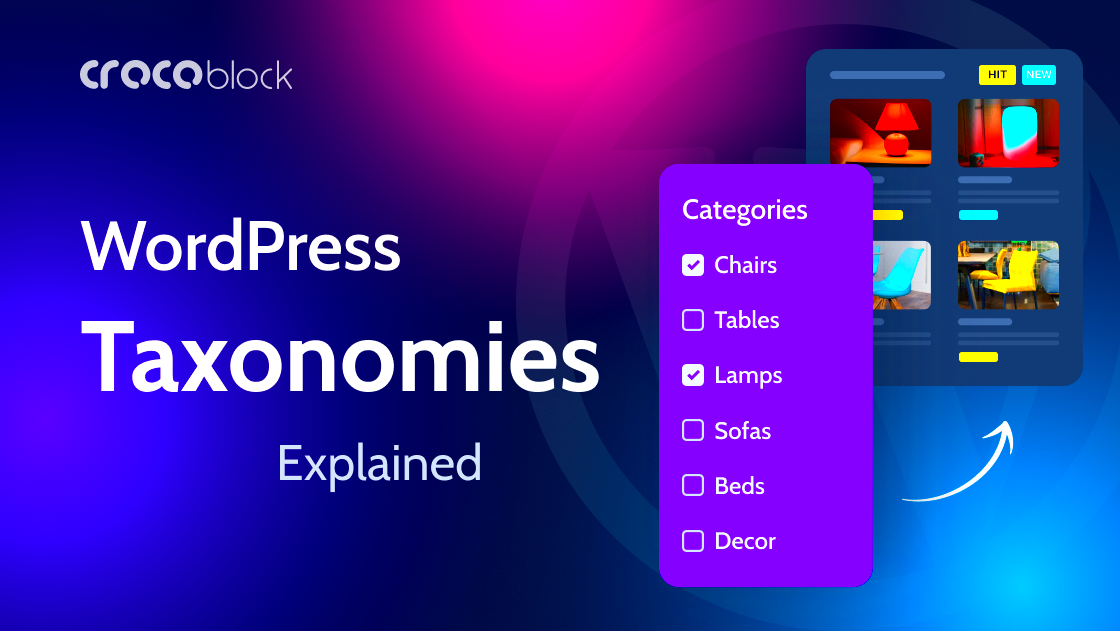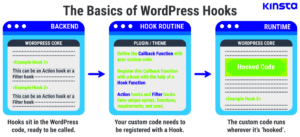Welcome to the fascinating world of WordPress taxonomies! If you’re wondering what taxonomies are and how they can enhance your website, you’re in the right place. In the simplest terms, taxonomies in WordPress are ways to group content together. They help organize your website’s data, making it easier for visitors to navigate and find what they’re looking for. In this blog post, we’ll delve deep into what taxonomies are, their types, and how to effectively utilize them.
What Are Taxonomies in WordPress?

At its core, a taxonomy is a system for categorizing content. In WordPress, taxonomies allow you to group your posts and pages based on shared characteristics. This grouping not only helps with organization but also enhances the user experience on your site. Here’s a closer look at what taxonomies are all about:
- Default Taxonomies: WordPress comes with two built-in taxonomies out of the box:
- Categories: These are hierarchical taxonomies, which means you can have subcategories. For example, you might have a main category called “Travel” with subcategories like “Europe,” “Asia,” or “North America.”
- Tags: Unlike categories, tags are non-hierarchical and help you describe your posts more specifically. For instance, if your travel post is about Paris, you might tag it with “France” and “Eiffel Tower.”
- Custom Taxonomies: Besides categories and tags, WordPress allows you to create custom taxonomies. These can be tailored to meet the specific needs of your site. For example, if you have a recipe blog, you could create taxonomies like “Cuisine” or “Cooking Method.”
To sum it up, taxonomies in WordPress are crucial for organizing content, helping both site owners and visitors make sense of various posts and pages. The ability to create custom taxonomies means you can really tailor your site to fit your unique content strategy!
3. Types of Taxonomies in WordPress
When diving into the world of WordPress, you’ll quickly discover that taxonomies play a vital role in organizing your content. In simple terms, taxonomies are a way to group similar content together. WordPress includes two main types of taxonomies, along with the ability for users to create custom ones. Let’s break those down.
1. Built-in Taxonomies
WordPress comes with a couple of default taxonomies that cater to most user needs:
- Categories: These allow for a broad grouping of related content. Think of it as the overarching theme of your posts. For instance, if you have a cooking blog, categories could include Desserts, Main Courses, and Appetizers.
- Tags: Tags are like keywords for your content. They’re more specific than categories and can help users find related content quickly. For example, under the Desserts category, you might use tags such as Chocolate, Gluten-Free, or Vegan.
2. Custom Taxonomies
One of the most flexible features of WordPress is the ability to create custom taxonomies. This is particularly helpful if your site has specialized content that needs more specific organization. For instance, if you’re running a book review site, you might create taxonomies based on Genres or Authors.
Here’s a quick comparison:
| Type | Description |
|---|---|
| Categories | Broad groupings for related posts. |
| Tags | Specific keywords for detailed categorization. |
| Custom Taxonomies | User-defined groupings to suit specific needs. |
Understanding these taxonomies is crucial for effective content organization on your WordPress site. It not only enhances user experience but also improves your site’s SEO! So, as you create or manage content, keep these taxonomies in mind and utilize them to their fullest potential!
4. Understanding Terms in WordPress Taxonomies
In the context of WordPress taxonomies, “terms” are like the individual labels used within those taxonomies. Imagine taxonomies as the broader categories and terms as the specifics that fill those categories. To better illustrate this, let’s break it down further.
What are Terms?
Terms are the chunks of words or phrases that represent the actual content within a taxonomy. For example:
- If you have a taxonomy titled Categories, the terms could be Desserts, Salads, or Drinks.
- In the case of a Tags taxonomy, the terms can be very specific like Chocolate Cake, Caesar Salad, or Smoothies.
Using Terms Effectively
Understanding how to use terms effectively can significantly enhance your site’s organization. Here are some tips for effective term usage:
- Be Descriptive: Terms should accurately represent the content they’re associated with. This helps in filtering and searching content more efficiently.
- Avoid Over-Categorization: While it’s good to have specific terms, creating too many can clutter your site. Strive for a balance.
- Consistency is Key: Use terms consistently across your site to maintain clarity and avoid confusion.
All in all, terms serve as the building blocks of your content classification in WordPress. So, the next time you’re adding a post, think carefully about the terms you choose to enrich your site’s taxonomy!
Default Taxonomies: Categories and Tags
When you dive into the world of WordPress, you’ll quickly discover two essential default taxonomies: Categories and Tags. These tools are your secret weapons for organizing content effectively, ensuring that your visitors can easily locate related materials on your site. Let’s break these down further.
Categories serve as the broad classifications of your content. Think of them as the chapters in a book. For instance, if you run a food blog, you might have categories like:
- Italian
- Desserts
- Healthy Eating
Categories are hierarchical, which means you can create subcategories for a more refined organization. For example, under ‘Italian,’ you might include ‘Pasta’ or ‘Pizza.’ This flexibility helps your audience navigate your content seamlessly.
On the other hand, Tags are more specific keywords that describe your posts in detail. They act like the index in a book, pinpointing the exact subjects covered within your content. Using our food blog example again, if you write an article on spaghetti carbonara, you might tag it with:
- Carbonara
- Pasta
- Italian Cuisine
Using both categories and tags lets you categorize your posts meaningfully, improving user experience and SEO potential. It’s essential to not go overboard with tags, as too many can confuse rather than clarify. A good rule of thumb is to stick to three to five relevant tags per post.
Custom Taxonomies: Creating and Managing Them
While default taxonomies like Categories and Tags are great for general organization, sometimes you need a tailored solution that fits your unique content. That’s where custom taxonomies come into play! They allow you to create your own classification system, making content organization as specific as you need it to be.
Creating custom taxonomies might sound complex, but it’s quite manageable. Here’s a simple step-by-step guide:
- Define Your Custom Taxonomy: Think about what specific topics or classifications your content falls under. This could be ‘Genres’ for a book review site or ‘Locations’ for a travel blog.
- Add the Custom Taxonomy: You can do this by using a plugin like Custom Post Type UI or by manually adding code to your theme’s functions.php file. If you’re not comfortable with code, a plugin is often the easier route.
- Assign Terms: Once your custom taxonomy is set up, you can add terms similar to how you would with categories and tags. If you created a ‘Genres’ taxonomy for a review site, your terms might be ‘Fiction,’ ‘Non-Fiction,’ and ‘Mystery.’
Managing custom taxonomies becomes straightforward once they’re set up. In the WordPress admin panel, they will appear like your default categories or tags. You can edit, delete, or add terms just as you normally would. Remember, the goal is to enhance user experience by making your content easier to navigate. So take the time to think through how custom taxonomies can benefit your site and its visitors!
7. Assigning Terms to Posts
So, you’ve got your taxonomies set up, and you’re probably wondering how to assign terms to your posts effectively. It’s actually quite straightforward, and doing it the right way can greatly enhance your site’s organization and usability.
When you create a post in WordPress, you usually see a section dedicated to categories and tags on the right side of the editor. This is where the magic happens. You can assign terms (think of them as labels) from your chosen taxonomies to categorize your content. Here’s how:
- Categories: These are broader terms that help to organize your posts into sections. It’s like an umbrella under which related posts reside. One post can belong to multiple categories, but it’s a good idea to keep it relevant.
- Tags: Tags are more specific and help users find content that focuses on particular topics within your posts. You can use as many tags as you feel are necessary, but don’t go overboard!
Aside from using these built-in options, you can also create custom taxonomies with unique terms tailored to your content. To assign a term to a post:
- Open the post editor.
- Locate the categories and tags panel on the right-hand side.
- Select existing terms or create new ones.
- Save your post, and voilà! Your post is now easier to find.
Remember, thoughtful term assignment can make your site’s navigation smoother and enhance the user experience. So take a moment to choose your terms wisely!
8. Using Taxonomy Queries in WordPress
Alright, let’s get a bit technical and talk about taxonomy queries. If you want to display posts based on specific taxonomies, understanding how to use taxonomy queries in WordPress will unlock a world of opportunity for organizing and showcasing your content.
Taxonomy queries allow you to retrieve posts that match specific terms within your registered taxonomies. This can be done using the WP_Query class, which gives you the flexibility to design custom loops. Here’s how you can use it:
$custom_query = new WP_Query(array( 'taxonomy' => 'your_taxonomy_name', 'field' => 'slug', 'terms' => 'your_term_slug',));
In this example:
- taxonomy: Specify which taxonomy you’re querying.
- field: This lets you define how you’re referencing your terms (ID, slug, name).
- terms: Here’s where you put the specific term you’re interested in.
You can even combine taxonomy queries with other parameters like post type, order, or date. This makes it incredibly powerful. Additionally, using taxonomies in your loops can create dynamic content sections and filter results based on user preferences.
Once you’ve executed your query, you can loop through the results and display them in your desired format. The possibilities are endless:
if ($custom_query->have_posts()) { while ($custom_query->have_posts()) { $custom_query->the_post(); // Display your content here } wp_reset_postdata();}
With a good grasp of taxonomy queries, you can take your WordPress site to the next level. It’s not just about organizing content; it’s about creating a tailored experience for your visitors!
Best Practices for Using Taxonomies and Terms
When it comes to maximizing the potential of taxonomies and terms in WordPress, following some best practices can make a world of difference. These strategies not only enhance the user experience but also contribute significantly to the overall search engine optimization (SEO) of your site.
- 1. Use Clear and Descriptive Slugs: When creating taxonomies, opt for slugs that are both descriptive and user-friendly. For instance, instead of a generic slug like “category-1”, use something more specific like “web-development”.
- 2. Limit the Number of Terms: While it can be tempting to create numerous terms, it’s better to focus on a smaller, more relevant set. Over-categorizing can lead to confusion for users and weaken your content’s relevance.
- 3. Maintain Consistency: Consistency in naming conventions is key. Ensure that similar terms are used throughout your site to reinforce themes and topics.
- 4. Utilize Hierarchical Taxonomies: For complex sites, taking advantage of hierarchical taxonomies can be beneficial. This allows you to create parent and child terms, making navigation smoother.
- 5. Regularly Review and Clean Up: Over time, certain terms may become outdated or redundant. Regularly revisiting your taxonomies ensures they remain relevant and functional.
- 6. Implement Tags Wisely: Tags can complement your primary categories. Use them to spotlight specific topics or keywords related to your content.
- 7. Optimize for SEO: Don’t forget to optimize your taxonomy archives. Use meta descriptions and titles that include relevant keywords to enhance searchability.
By following these best practices, you can ensure that your taxonomies and terms work for you rather than against you, streamlining how users interact with your site and making your content easier to navigate.
Conclusion: Optimizing Your WordPress Site with Taxonomies
In conclusion, taxonomies are a powerful tool in WordPress that can significantly enhance the organization, functionality, and discoverability of your content. Understanding how to use taxonomies and terms effectively is key to optimizing your site for both users and search engines.
Here are some quick takeaways:
- Structure Matters: A well-structured taxonomy makes it easier for visitors to find what they’re looking for, thereby improving user satisfaction.
- SEO Benefits: Properly implemented taxonomies can improve your SEO rankings, helping your content reach a broader audience.
- User Experience: A clear taxonomic structure leads to better navigation, which can encourage users to explore more pages and spend more time on your site.
- Content Management: Taxonomies facilitate better content management on the back end, allowing for easier updates and organization.
As you continue to build and refine your WordPress site, keep these insights in mind. With thoughtful implementation of taxonomies and terms, you’ll not only enhance the usability of your site but also pave the way for future growth and success. Rethink your corporate structures and user experiences—taxonomies are more than just labels; they’re your roadmap to a well-organized digital space!



